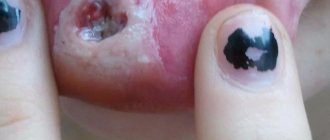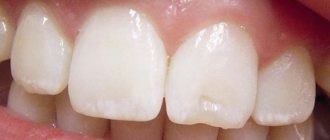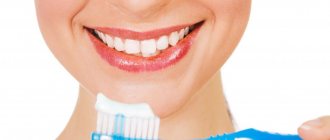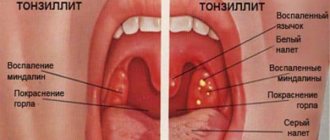Everything about increased acetone in a child - theory and doctor’s opinion
Anna Soloshchenko, a cardiologist of the highest category at the Alexander Hospital and author of the blog “Your Cardiologist,” told us what to do if a child’s acetone level has risen. And also compiled a list of preventive measures for such conditions.
You can immediately go to the specialist’s information by clicking here, or go deeper into the problem in detail - go to the theoretical and practical part of the article.
Acetone in a child is not a disease; on the contrary, it is a normal physiological process of metabolism, which is incorporated into the body as a backup option for obtaining energy. However, reacting to a situation incorrectly can have very serious consequences. To understand the causes and the correct algorithm for dealing with acetone in a child, read the article to the end. The material presents the theoretical part in an accessible language and gives specific practical recommendations for solving the problem.
All the necessary information about acetone in the body:
- What is acetone in a child?
- Reasons for increasing acetone
- Symptoms
- How to detect acetonemia?
- Risk group
- Why is acetone dangerous for a child?
- Basic principles of treatment
- How to reduce acetone at home?
- What should you feed your child?
- What should you not eat if you have acetonemia?
- Prevention of acetone syndrome
- Comprehensive information on acetone in children from Dr. Komarovsky
What is acetone in a child?
This is a temporary or pathological metabolic disorder in which a characteristic odor appears from the mouth and during urination (acetonemia). Acetone in a child is not limited to an unpleasant odor, its content in the blood sharply increases to toxic levels and leads to poisoning of the body as a whole; due to intoxication, attacks of vomiting and abdominal pain can be observed.
The main danger is dehydration of the body during attacks of severe vomiting, at which time the child loses a huge amount of fluid and it becomes impossible to replenish the reserves with the required energy and fluid in the usual way. It turns out to be a vicious circle. If a child refuses to drink or a gag reflex immediately occurs, you must immediately call an ambulance and be prepared for hospitalization; in the hospital, the child will be given a drip to replenish the necessary energy and fluid reserves.
You need to understand that hospitalization in a hospital and IV drips is an extreme measure; there are simpler ways to restore normal metabolism, which we will discuss below.
Return to content
Acetone aroma in mouth during fasting
Fashion trends of all kinds of diets have captured most of the female population and even some men. At the same time, food restrictions are caused not by medical indications, but by a banal desire to lose a couple of extra pounds. It is because of such “non-medical” diets that health often deteriorates greatly and the mouth begins to smell of acetone.
A diet that excludes carbohydrates can lead to an increase in the breakdown of fat deposits due to lack of energy, which causes the formation of acetone . The result will be an overflow of the body with harmful substances that cause intoxication and malfunction of all organs.
An acetone smell, saggy skin, brittle hair and nails, nervousness and a feeling of weakness - these are just some of the consequences of diets that exclude carbohydrates from the diet. Therefore, only experienced specialists should be involved in preparing a diet for people who want to lose weight.
Diabetes mellitus is another reason why your breath may smell like acetone.
Most adults with diabetes are familiar with the unpleasant odor of acetone on their breath. This is due to excess sugar in the blood, which, due to insulin deficiency, is not able to penetrate into the cells, which can lead to diabetic ketoacidosis , the main symptoms of which are the following:
- a strong acetone odor from the mouth and a positive urine ketone test;
- feeling of dryness and irresistible thirst;
- sharp abdominal pain and vomiting;
- severe depression of consciousness, up to a coma.
If any of the above symptoms are detected, it is necessary to immediately call for medical help , since without timely measures taken, this can lead to a coma and even death. People with the following risk factors should be especially careful:
- the initial stage of diabetes mellitus, which was discovered for the first time;
- secondary stage of diabetes mellitus caused by untimely use of insulin;
- infectious diseases, surgery or pregnancy in people with diabetes.
In this case, the following measures are used to combat diabetic ketoacidosis:
- the use of insulin, which is administered by drip in a hospital setting for treatment;
- prevention of dehydration;
- control of kidney and liver function.
As a preventive measure, patients with ketoacidosis should use insulin and monitor for any warning signs.
Thyroid disease is the cause of the smell of acetone in the mouth
The formation of an acetone odor due to pathologies associated with the thyroid gland is an alarming sign. Hyperthyroidism leads to a sharp increase in hormone levels, which can lead to a significant increase in the body's metabolism. At the same time, doctors identify the following reasons for the acetone odor in pathologies of the thyroid gland:
- Combination of hyperthyroidism with surgical intervention in the thyroid gland.
- In case of pregnancy and thyroid pathology.
- If the gland is not examined correctly.
Due to the sudden onset of a crisis, all its symptoms can also occur simultaneously:
- Pungent acetone odor from the mouth.
- Irritability or lethargy.
- Heat.
- Pain in the abdomen and jaundice.
The occurrence of a thyrotoxic crisis is quite dangerous and cannot be avoided without the help of a doctor. Patients are placed on a drip to prevent dehydration and stop thyroid hormones while maintaining the functioning of the liver and kidneys.
Reasons for increasing acetone
Doctor Komarovsky about the reasons for the appearance of acetone in children
To understand the mechanism of acetone in the blood of a child, you need to understand the theoretical part. Acetone is a common medical jargon for ketone bodies (acetone bodies), a group of metabolic products formed in the liver, but only when there is a lack of glucose.
Glucose is the main source of energy in the body of a child (and an adult). In the event of a sharp depletion of all glucose reserves (fasting of the body, active games, sports, severe stress, high temperature, etc.), the body begins to use the substance stored for this case to obtain energy - glycogen. The glycogen reserve in the body of an adult is sufficient for 1-2 days of normal functioning, approximately 500-700 g, and in the body of a child, the glycogen reserve is very low ~ 50-70 g, which is enough for 1-2 hours.
At the very moment when the body has used up all the glucose and glycogen available to it, fat becomes a source of energy. However, when producing energy from fats, a group of substances called ketone bodies is synthesized:
- Propanone (acetone).
- Acetoacetic acid (acetoacetate).
- Beta-hydroxybutyric acid (β-hydroxybutyrate).
It is because of the above 3 substances and their high concentration in the body that the smell of acetone appears from the child’s mouth and urine. When a critical
concentration
of ketone bodies in the body is reached, intoxication occurs; acetone affects the vomiting center in the brain.
Moreover, as can be understood from the theoretical part, such a reaction of the body is laid down at the genetic level and is the physiological norm for obtaining energy, the so-called plan “B”, during the absence of glucose in the body.
At the same time, ketone bodies can also be used (broken down) by the body to produce energy, but this requires certain enzymes, which are found in sufficient quantities only in children under 1 year of age, so infants do not have acetone. In children over 1 year of age and adults, the necessary enzymes are also produced, but 4-5 days after the appearance of acetone in the blood, and the symptoms of intoxication go away on their own.
In practice, the reasons for increased acetone in a child may be:
- respiratory infections;
- high temperature (often);
- sharp emotional overstrain, stress;
- physical exhaustion due to active games or physical activity, but only under unusual and heavy loads;
- diabetes
; - unhealthy diet (predominance of fatty foods);
- insufficient fluid intake, acetone is excreted from the body through urination; with small doses of fluid, it does not have time to leave in time and the concentration increases.
Return to content
Causes and mechanisms
If the rate of utilization is lower than the production of ketone bodies, then their content in the blood increases. This is observed in cases where the energy balance in the body is disturbed. Lack of glucose, the predominance of free fatty acids and ketogenic amino acids when meeting the body's needs are the main factors in switching metabolism to reserve substrates. This mechanism is compensatory and adaptive and is completely understandable from a biochemical point of view. The body needs fast energy, which is best obtained from ketones.
There are enough reasons why acetone in the blood increases in adults. These include the following situations:
- Decompensation of diabetes mellitus.
- Prolonged and profuse vomiting (toxicosis of pregnancy, intestinal infections, cicatricial pyloric stenosis).
- Alcoholism (withdrawal syndrome).
- Malnutrition and starvation.
- Severe thyrotoxicosis.
- Glycogenoses.
- Treatment with massive doses of glucocorticoids (for example, for autoimmune diseases).
Adults have a more efficient metabolism. In childhood, ketonemia can be provoked by stress, infectious diseases with fever, constitutional abnormalities (neuro-arthritic diathesis). And for adults, the most common situation with an increase in acetone is diabetes mellitus of the first (less often second) type. Enhanced ketogenesis is caused by a lack of insulin (absolute or relative) and an excess of catabolic hormones (glucagon, cortisol, somatotropin).
Severe vomiting is accompanied by dehydration, which also increases acetone in the blood. In those suffering from alcoholism, a different pathway of ketone production occurs, different from the compensatory one. Ethyl alcohol undergoes hepatic transformation to form acetaldehyde, which, in turn, promotes the synthesis of acetoacetic acid. In thyrotoxicosis, the mechanism of metabolic disorders is associated with the counter-insular action of thyroid hormones - increased breakdown of fats and proteins (basal metabolic activity increases).
The reasons for the increase in acetone in adults are quite varied. And to determine the source of the disturbances, you need to consult a doctor.
Symptoms
Symptoms of high concentrations of acetone in the body may include:
- weakness, lethargy, depressed state;
- lack of appetite, refusal to eat;
- characteristic odor of acetone from the mouth and when urinating;
- vomiting with a characteristic odor.
A high temperature may be due to a respiratory illness or inflammation and cause elevated ketone levels, but this is not necessarily a symptom.
Return to content
Acetone in urine in adults: norm, reasons for increase, symptoms, definition, how to reduce - About the Kidneys
Acetonuria is a common pathology today. This condition is characterized by the presence of acetone in the patient’s blood and urine.
Many believe that this is a temporary anomaly that cannot affect a person’s overall well-being.
In fact, acetone in the blood is a dangerous symptom that may indicate the presence of serious abnormalities in the functioning of systems and organs.
Acetone in urine in adults: causes, diagnosis and treatment
If acetone is detected in the urine during a test, this may indicate many human diseases. This substance is normally found in urine in small quantities. It is classified as ketones - products of incomplete oxidation of fats and proteins.
Today acetonuria, i.e. An increased concentration of acetone in urine is a fairly common phenomenon, although previously it was extremely rare. What may be related to the presence of this substance in the urine, how it is diagnosed and treated - questions that concern patients who have been diagnosed with the presence of this component.
Reasons for the presence of a substance in urine
A pressing question on many thematic forums among patients remains what it means if acetone is detected in the urine.
Normally, the substance content should be no more than 0.5 mmol/l.
Exceeding the normal value can be a consequence of many diseases or conditions. Acetonuria occurs in adults and children.
An increase in the level of acetone in the urine in adults, both men and women, can be caused by a number of reasons:
- Wrong eating habits . A deficiency in the diet of carbohydrates, the predominance of proteins and lipids leads to disruption of metabolic processes. It is also important not to consume foods that cause allergies. To do this, a hemotest is performed to determine food intolerance.
- Physical activity . Sometimes strenuous exercise can lead to acetonuria. Then adjustment of physical activity is required.
- Prolonged fasting and strict diet . In such cases, you will have to seek help from a nutritionist and develop an optimal nutrition plan.
- Diabetes . Acetonuria may be a consequence of pancreatic depletion in non-insulin-dependent diabetes or insulin-dependent diabetes.
- Thyrotoxicosis . When thyroid hormone levels increase, an increase in ketone bodies may occur.
- Hyperinsulinism . An increase in insulin concentration leads to a sharp decrease in blood glucose (hypoglycemia), which leads to acetonuria.
- Diseases of the digestive system . These include stenosis of the pylorus of the esophagus or stomach, the presence of cancerous tumors.
- Other causes are alcohol intoxication, cerebral coma, hyperthermia, toxicosis during pregnancy, anesthesia, central nervous system injuries, infectious pathologies, anemia, cachexia, poisoning with heavy metals and chemical compounds.
In preschool and adolescence, the disease develops under the influence of such factors:
- nutritional errors;
- overwork;
- strong physical activity;
- hypothermia;
- stressful situations;
- increased excitability;
- hyperthermia;
- helminthic infestations;
- dysentery and diathesis;
- taking antibiotics.
During pregnancy, the presence of acetone in the urine may be associated with a psycho-emotional state, the negative impact of negative external factors, toxicosis, decreased immunity, or consumption of products with dyes, chemicals, preservatives, etc.
: Acetone in urine: causes, symptoms, treatment, diets
Acetone in urine: causes, symptoms, treatment, diets
Symptoms of acetone in urine
- The clinical picture of acetonuria largely depends on the cause of the metabolic failure.
- The severity of symptoms is also influenced by general condition and age.
- There are a number of signs characteristic of acetonuria of various origins.
- The patient should pay attention to the following symptoms:
- lethargy and decreased performance;
- attacks of nausea and vomiting;
- smell of acetone in the mouth;
- pain in the stomach and head;
- acetone smell when urinating;
- hyperthermia.
In adulthood, the first signs of an increase in acetone levels are not pronounced. Initially, you feel weakness, nausea and general malaise. Due to oxygen starvation of brain cells, a person complains of migraines, and his breath smells of acetone.
When the concentration of acetone increases, the vomiting center is irritated, so the patient suffers from frequent, causeless bouts of vomiting. Constant vomiting leads to dehydration of the body. Without adequate therapy, a coma develops.
Young patients complain of other symptoms with acetonuria. Characteristic signs of the disease may be:
- Decreased appetite.
- Attacks of nausea and vomiting.
- Abdominal pain.
- Migraine.
- Smell of acetone in mouth.
- Hyperthermia.
- Lethargy and weakness.
- Dry tongue.
- Excitability by drowsiness .
- Pale and dry skin.
Children are also often diagnosed with acetonemic syndrome, or acetonemia - an increased content of ketone bodies in the blood.
This syndrome occurs with poor nutrition, viral infections and against the background of psycho-emotional stress.
Methods for diagnosing acetonuria
If the above symptoms appear, a person should seek medical help. Since an increase in the level of acetone in the urine can be caused by various reasons, this issue can be dealt with by an endocrinologist, infectious diseases specialist, gynecologist, resuscitator, gastroenterologist, oncologist, therapist or neurologist.
Source: https://uroscope.ru/diagnostika/atseton-v-moche-u-vzroslyh-norma-prichiny-povysheniya-simptomy-opredelenie-kak-snizit.html
How to detect acetonemia?
In the vast majority of cases, acetonemia is detected using the parent's sense of smell. The smell on a child's breath is quite pungent and difficult to confuse with something else.
If ketone bodies are detected in the blood, for the future, you can buy special tests for acetone at the pharmacy. The principle is quite simple, the child must go to a clean container for minor needs, and then a test strip is placed in the urine, which will give a positive result in the presence of acetone, and also shows the approximate quantitative concentration of acetone in the body.
If there is bad breath, no tests are needed, the conclusion is already clear - there is acetone and its amount in the body is increasing, measures need to be taken.
Return to content
Methods for determining acetone in urine
Laboratory and home tests can detect excess ketones. The most informative is a general urine test. At home, paper indicator strips are used, which are sold individually at pharmacy kiosks.
Lab tests
To determine the concentration of acetone, the doctor orders blood and urine tests. The urine donation algorithm is standard:
- In the morning, wash under running water without soap or gel.
- Collect morning urine in a special container or sterilized glass container.
- Close tightly and stick a piece of paper with data.
- The collected material is transferred to the laboratory.
The doctor may order you to retake the test if you have doubts about the diagnosis or to exclude false results due to a diet violation.
If a person is healthy, the acetone test result should be negative, since ketones are not normally detected.
Express test at home
The home analysis method is not as reliable because it does not determine the exact amount of acetone. The test strips show only high levels of ketones, giving the indicator a bright color.
You will need to purchase at least 3 indicator strips, since testing is carried out for 3 days in a row.
For home analysis, you will need a sterilized glass container. Algorithm of actions:
- Collect your morning urine sample.
- Lower the test to the specified level.
- Compare the colored indicator with that indicated in the instructions. The bright color of the indicator is a reason to visit a doctor.
Risk group
Children aged 1 to 7 years are most susceptible to acetonemia. If at least once in your life you smelled acetone from a child, then this may happen again in the future. As a rule, in the vast majority of cases this goes away after 7 years. If there are problems with acetone after 7, a medical examination is necessary.
In rare cases, acetone can be a symptom of diabetes if not treated correctly.
There is no specific risk group for children, except for the age category, it all depends on the physiological characteristics of each organism. One child may have a high content of acetone, but it is quickly excreted in the urine and does not have time to accumulate in critical concentrations. For another child, the moment from the onset of the smell to vomiting may be very short, which is dangerous.
Return to content
What causes an increase in acetone in the human body: what is it, its signs, diet
Acetone is an organic solvent that ranks first among ketones.
Ketone (acetone) bodies are formed during the breakdown of proteins and fats. Subsequently, they are eliminated from the body along with exhaled air and urine.
Normally, acetone is always present in the body, but in minute quantities. A significant increase in it indicates a malfunction in the body.
In the initial stages, an increase in acetone is noticeable only in the blood of adults, but as the pathology progresses, this substance also appears in large quantities in the urine (acetonuria, ketonuria).
Diagnosis of acetonemia, normal values
Diagnosis of acetonemia is traditionally made by performing a laboratory blood test. This is usually combined with a urine test.
Test results may contain a (+) or (-) sign. Moreover, there may be several “advantages” in the form.
In this case, the diagnostic results are interpreted as follows:
- (-) – the amount of ketones does not exceed 0.5 mmol/l;
- (+) – the level of ketones has reached 1.5 mmol/l (mild degree of pathology);
- (++) – up to 4 mmol/l (moderate acetonuria);
- (+++) – up to 10 mmol/l (severe course of the disease).
Normal levels of ketones in the blood are 1-2 mg/100 ml, and in the urine - 0.01-0.03 g.
If you wish, you can determine the presence of pathology at home using a special test. Externally, it is similar to many other test strips.
This test is impregnated with a special reagent on a certain area, which changes its color when in contact with a large amount of acetone. To understand how advanced the pathological process is, you need to compare the test strip after its contact with urine with the color scale on the packaging.
Causes
There are many reasons for the increase in acetone in the body of adults. These include:
- abuse of fatty and protein foods;
- lack of high carbohydrate foods in the diet;
- excessive physical activity;
- strict diet;
- type 1 diabetes mellitus or pancreatic depletion in type 2 diabetes;
- cerebral coma;
- increase in body temperature;
- poisoning with harmful substances, including alcohol;
- precomatose state;
- excess insulin;
- various serious diseases (cachexia, cancer, anemia);
- infectious processes in the body;
- use of chloroform for anesthesia;
- injuries in which the nervous system was damaged;
- excess thyroid hormones.
During pregnancy
In addition to all of the above, pregnant women may also have their own reasons for the increase in acetone.
Typically this is:
- stress (including those suffered in the past);
- decrease in the body's defenses;
- abuse of food that contains a lot of dyes, preservatives and flavors;
- toxicosis and, as a result, frequent vomiting;
- negative impact of the environment.
Regardless of the causes of acetonemia in pregnant women, it must be treated. This will help prevent the development of various consequences in the child.
Excessive acetone in children is usually diagnosed before the age of 12 years. It is up to this point that the pancreas continues to grow and often it cannot cope with the loads placed on it.
The most common causes of ketonemia in children include:
- poor nutrition;
- stress;
- overwork (both physical and mental);
- worms;
- intestinal infections;
- long-term use of antibacterial drugs;
- hypothermia;
- increase in body temperature.
Signs
In most cases, an increase in acetone in the body is accompanied by the following symptoms:
- strong smell of urine;
- smell of acetone from the mouth;
- depression;
- apathy, excessive fatigue;
- redness of the skin of the cheeks and pallor of the skin in other areas;
- dry mouth;
- nausea, urge to vomit;
- abdominal pain or discomfort;
- decreased appetite;
- sleep disturbance;
- increase in body temperature;
- disturbances in heart rhythm;
- decrease in the volume of urine excreted.
Among other things, if ketonemia is caused by any pathology, then the patient will also feel its symptoms. In the most severe cases, due to an increase in acetone, a person may become comatose.
Increased acetone in diabetes
If the human body is healthy and functioning properly, then glucose, entering the kidneys, undergoes glomerular filtration, and is then completely absorbed by the renal tubules and enters the blood.
However, if this process is disrupted, glucose can be found in the urine. Sugar is usually present in urine in patients suffering from diabetes. Acetone is often found in their urine.
This happens because the body's cells are starving, even though the amount of sugar in the blood is rising. Glucose deficiency provokes the breakdown of fat reserves, while one of the reasons for the increase in ammonia is the breakdown of fats.
Patients with high acetone and diabetes mellitus experience rapid breathing, weakness, vomiting, dry mouth and constant thirst.
Basic actions when detecting acetonuria in adults
If studies have shown an increase in the amount of acetone in the body, you need to start therapy as soon as possible.
In addition, it is very important to perform a blood glucose test. This is necessary to exclude diabetes mellitus. Then you need to establish the exact amount of ketone bodies in the urine and draw up a treatment plan. It will directly depend on the severity of the disease, the causes of its occurrence and the individual characteristics of the patient’s body.
At the time of treatment, the patient should spend as much time as possible in the fresh air, alternate work with rest, avoid stress, and also adhere to a sleep-wake schedule. Drinking plenty of fluids will help speed up the elimination of acetone. Moreover, it is desirable that it be not just compotes and teas, but water. You need to drink it often, but little by little.
Drug therapy
Treatment for ketonemia will depend on how advanced it is. So, while some patients only need to adjust their diet, others require hospitalization.
Quite often, for this pathology, Regidron or Orsol is prescribed. If a person cannot drink enough water due to constant vomiting, he is given intravenous fluids using a dropper.
Also, in case of severe vomiting, Cerucal can be prescribed. To speed up the elimination of toxins and ammonia, it is useful for patients to drink activated carbon or any other sorbents.
B vitamins can also be beneficial in this case.
Among other things, drug treatment of the underlying disease must be carried out. Thus, for diabetes mellitus it is necessary to use insulin, for intestinal infections - antibacterial agents, etc.
Nutrition
No treatment will help the patient get rid of ketonemia if he does not adhere to the diet.
In this case, it is allowed to eat boiled or stewed meat. Preferably veal or rabbit. You can also eat vegetable soups, fish (it should not be fatty) and various cereals.
Raw vegetables, fruits, berries (as well as various drinks made from them) can be consumed in unlimited quantities. They will help improve your water balance, replenish your supply of vitamins and thereby strengthen your immune system.
With ketonemia, quince can be of great benefit. You can use it in any form.
Fatty meats, broths, sweet dishes, canned food, and spices are strictly contraindicated for this pathology. It is also highly undesirable to eat fried foods, citrus fruits and bananas.
Traditional methods
Traditional medicine can also help reduce the amount of acetone in the body. However, before using this or that remedy, the patient should consult a doctor on this topic.
Chamomile decoction
To prepare the remedy you will need chamomile inflorescences. This is done simply: 4 tbsp. l. dry powdered plant is poured with 1500 ml of clean water, after which the whole thing is put on fire and cooked for about 5 minutes.
The finished product is cooled and filtered through gauze folded in several layers. The medicine is used in the dosage prescribed by the attending physician.
Salt enema
In order to alleviate the patient’s condition as quickly as possible, it is recommended that he perform a salt enema. This will help with severe vomiting, disruption of neurological processes, as well as improper water exchange. This enema is especially useful for impaired consciousness, as well as for severe intestinal infections.
The solution for such an enema is prepared as follows: 1 tbsp. l. salt is diluted in 1000 ml of warm, pre-boiled water.
Garlic
For ketonemia, a medicinal drink based on garlic can also be quite effective. To prepare it you need to peel 3-4 cloves of garlic and chop them in a garlic press. Then the resulting mass should be poured with 300 ml of hot water. Wrap the container in a towel and place in a warm place. Thus, the drink should be infused for 15-20 minutes.
Drink the finished product ¼ of a glass three times a day (regardless of meals).
Why is acetone dangerous for a child?
It is important to prevent the appearance of ketones (acetone) in high concentrations! If ketone bodies accumulate in the body in a critical concentration, they begin to act on the vomiting center and appetite center in the brain, the child refuses to eat, and when trying to take liquid, vomiting immediately occurs.
Children's acetone does not pose a direct threat to health and life, but the consequences, such as dehydration with constant vomiting and the inability to take liquids orally, are deadly for the body
!
If it is impossible to give the child water to drink and there is continuous vomiting, a hospital and IV drips are required.
Return to content
Features of therapy for diabetes mellitus
Treatment of such patients requires a special approach. As for how to remove acetone from the body of an adult with diabetes, in this case treatment will include the following measures:
- insulin therapy;
- rehydration;
- antibacterial therapy.
To remove toxins and ketone bodies in insulin-dependent diabetes mellitus, taking diuretics and drinking plenty of fluids is indicated. In addition, additional administration of insulin is necessary to normalize glycemia or an intravenous drip. Such activities are carried out strictly under the supervision of a doctor in a hospital setting.
Since acetone often leads to a decrease in blood pH, the patient is prescribed an alkaline drink in the form of medicinal table mineral water without gas or a soda water solution to correct the acid balance.
Basic principles of treatment
The main principle of treating acetone in a child is not
in its neutralization, but in eliminating the cause of intensive formation of ketone bodies!
The child needs to be given glucose (sweets, glucose-containing drinks)
. This will restore the normal process of obtaining energy from glucose, thereby stopping the breakdown of fats and the formation of new acetone molecules.
If the body refuses to accept sweets and drinks, it is necessary to put in a glucose drip to replenish normal metabolism and fluid.
The basic principle - sweets at the right time - cures acetone in a child!
Return to content
Treatment
Treatment methods for acetone
Before starting treatment of this pathology, it is necessary to identify the causes that led to the development of acetonuria.
Elimination of acetone from the patient’s body can be carried out using the following methods:
- Following a strict diet with limited foods high in protein and fat.
- Filling the patient's diet with dishes that contain large amounts of carbohydrates.
- Organization of the drinking regime, that is, the patient drinks a lot of alkaline liquid - mineral water and soda solution.
- Injection of insulin into the body.
- Conducting alkaline cleansing enemas.
- Prescription of intravenous drip infusions of saline solution.
In addition, drug therapy is prescribed, which includes treatment with methionine, Essentiale, enterodesis and enterosorbents such as:
- Smecta
- Polyphepan
- Filtrum
- Polysorb
Diet for pathology
Proper nutrition for acetonuria
A prerequisite for removing acetone from the human body is strict adherence to the diet:
- It is allowed to consume such types of meat as beef, turkey and rabbit, which are recommended to be boiled, stewed or baked.
- It is allowed to eat various vegetable soups, low-fat fish and cereals.
- To restore water balance and saturate the body with vitamins, the patient can consume vegetables, fruits, as well as fruit drinks and compotes prepared on their basis.
- With such a pathology as acetonuria, quince is considered a useful fruit, from which it is recommended to prepare compotes or jam.
An increase in acetone in the patient’s body requires giving up such foods as:
- Fatty meats and broths based on them
- Spices
- Sweet products
- Fried foods
- Citrus fruits and bananas
Acetonuria is a dangerous pathological condition of the body, both in adults and children. If appropriate treatment is not carried out, the patient may fall into a coma or die.
We suggest you read: What affects blood sugar. How to normalize sugar in diabetes
If we are talking about a relatively mild form of development of the pathological condition, therapy can be carried out without placing the person in the hospital. In certain situations, drinking plenty of fluids and increasing blood sugar levels is already more than enough to reduce the acetone ratio.
We are talking about Polysorb, Smecta, Enterosgel, Filtrum and many other medicines. In addition, it is permissible to perform an enema. It is necessary to pay attention to the fact that it is quite possible to prepare a special cleansing enema even at home.
In mild cases of acetone crisis, treatment can be carried out on an outpatient basis, that is, without placing the child in a hospital.
Treatment of a child with elevated acetone comes down primarily to providing his body with the necessary amount of fluid, glucose and removing ketone bodies as soon as possible.
He needs to be given more water to drink, including sweet water. Blood glucose levels are greatly increased by tea with a few spoons of sugar or honey, a five percent glucose solution, compotes made from various dried fruits, and also rehydron. Sweet water should sometimes be alternated with alkaline mineral water or rice water.
Since with increased acetone, almost any liquid can provoke vomiting, children are given it in very small quantities, no more than a teaspoon, but quite often - once every five minutes.
Important: when treating high acetone, it is necessary to desolder the child not only during the day, but also at night.
In some cases, drinking plenty of fluids and increasing glucose levels is already enough to reduce acetone in the blood, but often these measures do not bring the desired effect, and then it is necessary to carry out measures to remove ketones.
To do this, they use enterosorbents such as Polysorb, Smecta, Enterosgel, Filtrum, Polyfipan and others, and also do enemas. A cleansing enema can be prepared from one teaspoon of soda diluted in a liter of warm boiled water.
Much attention should be paid to the child's nutrition. If there is a complete lack of appetite, you should not “stuff” your child with food, but you also should not force him to starve, as this can lead to fainting and exhaustion.
- Semolina porridge;
- Oatmeal;
- Mashed potatoes;
- Carrot puree;
- Vegetable soups;
- Baked apples;
- Cracker.
This diet should be followed for several weeks until the child’s well-being is completely normalized, his appetite is restored, and the amount of acetone decreases. To add some variety to your diet, you can change the menu every week.
Important: purees and cereals for a child with high acetone should be prepared only with water!
If in the second or third week of the diet the child begins to feel better, you can add lean meat (baked or boiled) and stale bread to the foods listed above. With further improvement of the child's condition, he can be given ripe tomatoes, sauerkraut (non-sour), fresh vegetables and herbs.
Only a doctor can begin therapy after making a diagnosis. This cannot be done at home.
Hospitalization is usually not required, so treatment can be carried out at home, but under the supervision of specialists. Different treatment methods are used in different cases.
Therapy has the following goals:
- decreased levels of acetone (ketones in the blood and urine);
- eliminating symptoms of ketone poisoning;
- nutrition adjustments;
- eliminating the cause of the pathology.
If the cause of the disease is an infection, then antibiotics will be prescribed.
In case of disturbances in the functioning of internal organs, treatment will be systemic at the discretion of the doctor. To cleanse the body of acetone, the child is prescribed enterosorbents (Polysorb, Activated Carbon, Smecta, etc.).
An increased level of acetone is accompanied by carbohydrate starvation, so in some cases the child is given drips containing glucose to restore strength. At the same time, it is necessary to replenish the lack of fluid in the body caused by vomiting and frequent urination.
In each individual case, treatment is selected individually, that is, there is no single way to treat acetone in the urine, since there are many reasons.
However, acetone levels can be influenced by diet, which is an important element in treatment.
We suggest you read: Learn more about the causes of diabetes
To do this, first of all, you should not starve or, on the contrary, overeat. During periods of exacerbation, you should enrich your diet with carbohydrate-containing foods: fermented milk products, vegetables, fruits, jam, honey, cookies. Sweets are allowed, but in reasonable quantities and in the absence of diabetes.
It is also necessary to reduce the amount of fat and protein consumed. You should not eat meat broths, smoked foods, spicy foods, chocolate, fast food and foods containing preservatives. It is important to monitor the child’s lifestyle.
He must go to bed and get up at the same time, that is, follow a routine. Sleep should last at least 8 hours a day. It is useful to take walks in the fresh air, but it is harmful to sit at the computer for a long time.
The appearance of acetone in urine is observed up to 12 years of age. After this, the enzymatic system is already fully formed and there should be no relapses unless there are serious diseases.
In any case, increased acetone in the urine is associated with poor diet or lifestyle, so you need to look for the problem and eliminate it in this direction.
At the first symptoms of this problem, it is better to consult a doctor who can select adequate treatment and quickly get rid of the disease.
To remove the acetone contained in the urine in diabetes, you should saturate the body with the right glucose. It is enough to give the child some sweets to eat.
You can remove acetone without causing vomiting using sweetened tea, fruit juice or compote. Sweet drinks should be given 1 teaspoon every 5 minutes.
In addition, you can remove acetone if you adhere to a diet based on light carbohydrates:
- vegetable broths;
- semolina;
- mashed potatoes;
- oatmeal and stuff.
Also, to remove ketone particles in diabetes, cleansing enemas are done. And in especially difficult situations, acetone can be removed only in hospitalization.
Don't self-medicate!
Acetone syndrome or Acetone in a child is a condition caused by an increase in ketone bodies in the blood. Often detected by the smell of acetone from the child’s mouth, an unusual smell of urine, nausea and vomiting. All these signs mean that the level of acetone in the child’s body is exceeded, so it is released in the urine and poisons the body, causing a bad breath.
Acetonemia is a serious problem; if you cannot eliminate the symptoms on your own, you need to go to the hospital. With proper treatment, acetone returns to normal in children with age. (Komarovsky).
If a urine test shows acetone, then you can get rid of it only if you follow all the recommendations of a specialized specialist. The patient is prescribed Orsol or Regidron medications to restore the acid-base balance.
It is useful to drink alkaline water without gases with acetone, and in case of severe vomiting, inject with the drug “Cerucal”. To remove toxins from the body, it is recommended to take Sorbex or White Coal.
One of the common pathologies is acetonuria, which is accompanied by the appearance of acetone and other ketone bodies in the patient’s urine. Many people have the opinion that acetone in the urine is a temporary deviation that does not affect the human condition in any way.
How to reduce acetone at home?
All the mechanisms for this are in the body; there is no need to invent anything. It is necessary to give the child glucose to restore normal metabolism and drink plenty of fluids to quickly remove acetone bodies from the body.
Theoretically, alkaline water can neutralize acetone on a chemical level, but it has not been medically proven to be an effective treatment for acetonemia. Sweet compotes, sweet tea, water with honey or sugar and drinks with a high glucose content (Coca-cola, Pepsi, Fanta, etc.) will be much more effective.
Diet with acetone
At the very beginning of treatment, the patient is recommended to fast. At least for a day. In combination with plenty of drinking, fasting will help get rid of the symptoms of poisoning. Over the next few days, it is recommended to follow a gentle diet. Oatmeal cooked in water, crackers, and vegetable broths will be beneficial for the patient. Gradually, you can introduce mashed potatoes and baked apples into your diet.
It is strictly forbidden to consume fried foods, concentrated meat broths, sausages, smoked foods, carbonated drinks, canned food, cocoa and chocolate, chips, etc.
What should you feed your child?
Doctor Komarovsky - what should you give a child with acetonemia?
If acetone has already shown itself, then you shouldn’t even think about feeding the child by force. To digest food, the body requires energy, which means fats will be broken down and acetone bodies will be formed in even larger quantities. The child first needs to be given drinks, sweet water, or ideally a concentrated glucose solution, which can be bought at any pharmacy.
If you manage to give a glucose-containing liquid, that’s good, after a while you can start giving fruit. Ideal - raisins, fresh grapes, dried apricots, prunes, peaches, bananas, apples, sweets - sweets, chocolate, jam, etc. If there are improvements - porridge and any foods high in carbohydrates. This is the acetone diet for children.
Return to content
What are the consequences of the presence of acetone in the patient’s blood and urine?
Acetonuria is a common pathology today. This condition is characterized by the presence of acetone in the patient’s blood and urine.
Many believe that this is a temporary anomaly that cannot affect a person’s overall well-being.
In fact, acetone in the blood is a dangerous symptom that may indicate the presence of serious abnormalities in the functioning of systems and organs.
What is acetone in the blood
Most often, acetone appears in the blood due to a violation of fat metabolism, as well as the absorption of carbohydrates.
A synonym for acetone in the blood is acetonemia.
This condition is accompanied by the accumulation of a significant amount of ketone bodies in the human body. They first appear in the blood, and then in urine. However, diagnosis of pathology is carried out through urine analysis. This test is the most effective way to detect acetonemia.
Acetonuria can be detected at home using special test strips
Today, the level of acetone can be easily determined at home. To do this, test strips are used, which are lowered into a container with urine. They acquire a pink tint if traces of acetone are observed in the urine; in the case of pronounced acetonuria, the stripes turn purple.
Acetone content rate
Ketone bodies are normally absent in the blood.
More precisely, their blood contains no more than 1–2 mg per 100 ml. This indicator is so insignificant that it cannot be diagnosed using standard laboratory tests.
Ketone bodies are chemical compounds formed in the human liver from foods that come from outside. Their formation occurs thanks to proteins and fats. Ketone bodies are necessary in small quantities for humans because they are a source of energy. If their level exceeds the norm, this threatens intoxication of the body.
Symptoms of the presence of acetone
There are a number of symptoms and signs that may indicate the development of an acetone crisis:
- Refusal of food and water due to nausea and lack of appetite.
- Every meal is accompanied by vomiting, which can also be permanent.
- The presence of signs of dehydration: the level of urine output is reduced, the skin is pale and dry, weakness is felt, etc.
- Signs of a malfunction of the central nervous system (CNS) - the initial excitement is quickly replaced by a lethargic state and drowsiness. There is a possibility of seizures.
- An elevated temperature is observed.
- The smell of acetone appears from the mouth, urine has a similar smell, as well as vomit.
- The liver increases in size.
- A biochemical blood test shows that the level of chlorides and glucose is reduced, cholesterol and lipoproteins, on the contrary, are observed in increased quantities. The general analysis demonstrates an increased content of leukocytes and ESR.
Assessment of the degree of acetone syndrome in children - table
| Clinical symptoms | Clinical interpretation | |||
| 0 | 1 | 2 | 3 | |
| Symptoms of intoxication | none | minor | moderate | expressed |
| Vomit | none | from 2 to 5 times | from 5 to 10 times | 10 or more times |
| Abdominal pain | none | weak | moderate | strong |
| Appetite | saved | reduced | sharply reduced | none |
| Thirst | drinks normally | drinks greedily | drinks sluggishly | doesn't drink |
| Degree of acetonuria | missing(-) | minor(+, ++) | moderate(+++) | expressed(++++) |
Reasons for the increase
Acetone levels may increase for the following reasons:
- improper diet, in which the body does not receive the necessary nutrients and vitamins. This is often observed when a person is fasting, eats mainly foods with a high fat content, when introducing a significant amount of protein into food and cutting carbohydrates, and also if the body is subjected to excessive physical stress;
- progression of diabetes mellitus;
- surgical intervention, which was accompanied by the use of general anesthesia;
- poisoning of the body with toxins;
- increased body temperature;
- excessive drinking;
- the presence of toxicosis during pregnancy, which is accompanied by constant vomiting;
- progression of pathological conditions: the presence of malignant tumors in the gastrointestinal tract;
- various infectious diseases;
- liver pathologies;
What are the consequences of deviation from the norm?
If the problem of increased acetone is detected in a child or pregnant woman, emergency hospitalization is required, since doctors consider this condition dangerous. As a result of increased accumulation of ketone bodies in the human body, the following complications and consequences may occur:
- dehydration/intoxication;
- premature birth, miscarriage;
- coma and even death.
Note! Ketonemia is a condition that occurs when acetone enters the bloodstream. Ketonuria occurs when the level of ketones in the blood reaches its critical point.
Normalization methods
Acetone, which appears in diabetes, can be removed by saturating the human body with the correct glucose. To do this, just eat something sweet.
It is possible to remove acetone from the body by drinking a significant amount of liquid. However, it is difficult to do this on your own due to the repeated vomiting that accompanies the condition.
Sweetened tea, fruit juice or compote will help rid the body of acetone without causing vomiting. This drink should be given a teaspoon every few minutes.
Fruit juice will help rid the body of acetone without causing vomiting
It is also possible to get rid of acetone with the help of a proper diet, which will be based on the consumption of light carbohydrates: semolina or oatmeal, mashed potatoes, vegetable broth, etc.
Diet requirements:
- Meat can only be dietary: rabbit, turkey, veal. It is recommended to stew, boil, bake;
- fish should be lean (for example, hake, pollock);
- vegetables and fruits will help restore water balance. Quince is useful for acetonuria; compote or jam is made from it. The consumption of citrus fruits and bananas is not recommended.
Products that help normalize the condition - gallery
Fruits Vegetables Pollock, cooked in the oven Rabbit meat Boiled turkey
To remove ketone particles in diabetes, cleansing enemas are given. In especially severe cases, acetone can only be eliminated during hospitalization.
It is possible to prescribe medications that prevent dehydration. For this purpose, a solution called Regidron or its analogues, which can normalize water-salt metabolism, is suitable. Additionally, a glucose solution with a concentration of 5% can be used. Enterosorbents are also shown, including Smecta, Enterosgel, Filtrum, etc.
Prevention of high acetone content
To prevent the appearance of acetone, an adult must adhere to these simple rules:
- systematically engage in sports;
- give up all bad habits;
- maintain a proper diet;
- undergo regular medical examination.
To prevent the appearance of acetone in a child, it is enough to monitor the products he consumes:
- give up chips, sweet carbonated drinks, fatty foods, smoked meats and processed foods;
- Replace sweets from the store with natural fruits and homemade desserts.
Doctor Komarovsky about acetone in a child’s urine - video
It is important to remember that acetone in urine and blood occurs quite often, and the cause of its appearance can be both metabolic disorders in the human body, which are temporary, and serious chronic diseases, for example, diabetes. Whatever causes this condition, it can progress and become life-threatening.
Source: https://lechenie-diabet.ru/atseton-v-krovi.html
About prevention
A child has stress - sweet, active games - sweet, physical activity - sweet, cold - sweet, high temperature - sweet. It is important not to feed with sweets, which can lead to obesity, namely, not to allow all glucose and very small volumes of glycogen to be consumed; if this happens, the process of synthesis of acetone bodies (acetone production) will inevitably start.
If the first manifestation of acetone in a child occurred after the age of 4 years or periodically continues after 7 years, this is a reason for an in-depth medical examination; it should not be like this!
Folk remedies
Chamomile decoction
If an adult's urine tests revealed acetone in the urine, you can drink a healing infusion made from chamomile inflorescences. To prepare it, take 4 large spoons of the plant and pour in 1.5 liters of purified water.
Salt enema
To treat acetonuria in adults, a soda enema is used, but this procedure is not always used. An enema is relevant for frequent vomiting, neurological abnormalities and disruption of water exchange processes.
In addition, they resort to an enema if the acetone in the urine provokes an infection that should be removed from the intestines or if the patient’s consciousness is impaired. To prepare a cleansing enema you need 1 tbsp. l. Dilute salts in 1 liter of warm water.
Copying site materials is possible without prior approval if you install an active indexed link to our site.
Attention! The information published on the site is for informational purposes only and does not constitute a recommendation for use. Be sure to consult with your doctor!
Ways to reduce acetone in the body of children
Parents of such children should know how to remove acetone from the body. Your home first aid kit should contain:
- test strips for determining acetone in urine;
- glucose tablets;
- 40% glucose solution in ampoules;
- 5% glucose in bottles.
Treatment of acetone in children involves removing ketones from the body and saturating it with glucose. For this purpose, the patient is prescribed:
- drinking plenty of water;
- use of enterosorbents;
- cleansing enema.
In order to replenish liver reserves, it is necessary to alternate between plain water and sweet drinks. These include:
- tea with sugar or honey;
- compote;
- glucose.
In addition, there are special powders to replenish salts lost through vomiting. These include:
- rehydron;
- trihydrone;
- hydrovit.
The patient should not be forced to drink large amounts at one time. When vomiting, the volume of liquid should not exceed one teaspoon every 5-10 minutes. If vomiting is uncontrollable and the liquid you drink is not absorbed, you can give an antiemetic injection. It will bring relief for several hours, during which time the child must be given a drink.
After stopping the acetonemic crisis, adults should not relax. They need to reconsider their child’s daily routine, physical activity and nutrition.
Children prone to the appearance of acetone must constantly adhere to their diet. They should not be in the sun for long and experience too many emotions - no matter positive or negative. Big holidays, sporting events, Olympics should only be held with proper nutrition, and in some cases, it is better to abandon them altogether.
To improve the condition of the nervous system and metabolism, the child is shown:
- massage;
- pool;
- children's yoga;
- walks in the open air.
It is also necessary to limit the time spent in front of the TV and computer. Such children should sleep at least 8 hours a day.
Children with diathesis must be breastfed for a long time. The introduction of complementary foods should be done carefully and as late as possible. The mother of such a baby should keep a food diary, which will indicate the type of complementary foods and the reaction to it.
The food must contain:
- lean meat;
- sea fish and algae;
- dairy and fermented milk products;
- fresh vegetables and fruits;
- porridge;
- jam, honey, nuts in small quantities.
Prohibited foods, consumption should be completely limited:
- fat meat;
- fast food;
- semi-finished products;
- fatty fish;
- sparkling water, coffee;
- buns;
- sour cream, mayonnaise, mustard;
- canned food;
- legumes, radishes, radishes, mushrooms, turnips.
All these measures will help reduce the frequency of attacks and provide the child with a full and healthy life.
Causes
There are many reasons for the increase in acetone in the body of adults. These include:
- abuse of fatty and protein foods;
- lack of high carbohydrate foods in the diet;
- excessive physical activity;
- strict diet;
- type 1 diabetes mellitus or pancreatic depletion in type 2 diabetes;
- cerebral coma;
- increase in body temperature;
- poisoning with harmful substances, including alcohol;
- precomatose state;
- excess insulin;
- various serious diseases (cachexia, cancer, anemia);
- infectious processes in the body;
- use of chloroform for anesthesia;
- injuries in which the nervous system was damaged;
- excess thyroid hormones.
During pregnancy
In addition to all of the above, pregnant women may also have their own reasons for the increase in acetone.
Typically this is:
- stress (including those suffered in the past);
- decrease in the body's defenses;
- abuse of food that contains a lot of dyes, preservatives and flavors;
- toxicosis and, as a result, frequent vomiting;
- negative impact of the environment.
In children
Excessive acetone in children is usually diagnosed before the age of 12 years. It is up to this point that the pancreas continues to grow and often it cannot cope with the loads placed on it.
The most common causes of ketonemia in children include:
- poor nutrition;
- stress;
- overwork (both physical and mental);
- worms;
- intestinal infections;
- long-term use of antibacterial drugs;
- hypothermia;
- increase in body temperature.











